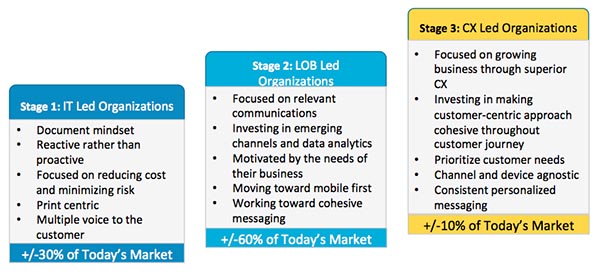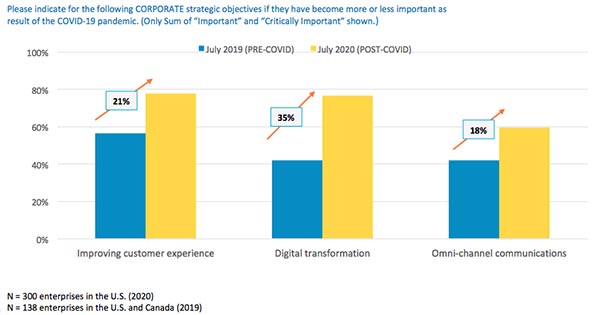As we enter the third decade of the 21st century, the Customer Communications Management (CCM) market is undergoing radical changes on an evolutionary scale. In order to better understand the forces behind this evolution, late last year, Aspire CCS surveyed businesses across the globe, interviewed stakeholders in every facet of the market, and published an extensive report entitled, “The State of CCM-to-CXM Transformation.”
This, the final entry in a four-part seriespublished in partnership with WhatTheyThink,will focus on how enterprises can leverage the unique forces currently disrupting the industry to transform their customer communications workflow into a vehicle that drives revenue by maximizing a consumer’s lifetime value. (See Part 1, Part 2, and Part 3.)
As we detailed in our previous articles, even before the COVID-19 pandemic, shifting enterprise priorities, a rapidly changing technological landscape, and the migration from on-premise CCM installation toward cloud-based distribution were all moving the market away from customer communications focused on reducing cost and risk toward a strategy that would use communications to improve customer experience (CX). This paradigm shift is so significant that Aspire believes Customer Communications Management has effectively become part of Customer Experience Management (CXM), or the practice of managing all interactions that a business conducts with its customers with the express goal of improving the perception that customers have about that business. The zenith of this transformation would see an indelible shift from traditional outbound messaging triggered by regulatory requirements toward customer-centric, two-way interactions based on consumer’s needs and calibrated to their preference and convenience.
For enterprises, there are three stages along the path from CCM to CXM, each determined by the business unit making customer communications decisions.
Figure 1. Enterprise CXM Maturity Model

Source: Aspire, The State of CCM-to-CXM Transformation, 2019
In 2019, we estimated that only 10% of the market had achieved true CXM, but our newly published research, entitled “Understanding the New Digital Reality,” reveals that COVID-19 has greatly accelerated the transformation. Not only has consumer digital adoption—and subsequently, enterprise digitization of customer communications—experienced an unprecedented surge, but this once-in-a-century pandemic has sharpened business focus on customer retention through better communication. Enterprises are anxious to hold onto the customers they have by improving CX through superior digital interaction.
Consumers—especially younger and more tech-savvy ones wielding increasing buying power—want personalization (the essence of which is relevance), channel choice, and a consistent experience across all mediums and at every stage of the customer journey. As a result, the traditional static, outbound, document-centric way of communicating is being replaced with a data-driven, bi-directional approach. Customer communications are not created in isolation from the rest of the business and sooner-or-later market realities will force organizations to evolve their CCM into a CX model. Going forward, CX will be become even more of a competitive differentiator than it is today, particularly in highly regulated markets.
Figure 2. Strategic Objectives Emphasize Digital Comms in Customer Retention

Source: Aspire, Understanding the New Digital Reality, 2020
As a case in point, between 2019 and 2020, the reported priority of improving customer experience shot up 21% and the importance of digital transformation increased by nearly 40%! Savvy enterprises are constantly raising the bar, and our research shows that CX-driven communication leaders enjoy 41% higher revenue growth than their peers who still rely on static, outbound communications.
About this time last year, Aspire partnered with a European utilities provider, advising them on how they could modernize their approach to customer communications. When their transactional outsourcing contract came up for renewal, it provided them with a unique opportunity to reevaluate their CCM strategy. While the company recognized the need for change and had already taken steps toward procuring the necessary tech and talent, their nascent efforts were hindered by their organizational structure. Without a unified strategy, centralized communications control, or a single platform for different communication types, the gulf between transactional, marketing, and business function communications would continue to widen. This disconnect was exacerbated by limited coordination between functional silos, making it impossible for them to provide a seamless, omni-channel experience across the customer lifecycle. Furthermore, issues with data integration made it difficult to obtain a single view of customer.
As Aspire explained, if they adopted a central dashboard for reporting and a single unit of measurement to gauge success (KPIs), the business could drive customer behavior toward mutually beneficial outcomes. They also had an opportunity to enhance their digital communications by facilitating true interaction and framing communications around customer needs rather than the organization’s capabilities.
Rather than negotiate a new contract on the same outdated terms, locking it in the status quo and hampering business agility, Aspire recommended that the business first evolve their organizational structure by creating a shared service with centralized control of communications and content creation while investing in more modern IT capabilities that empower business users.
In short, establishing central leadership over CCM would enable the enterprise to identify, evaluate, execute on opportunities to positively influence customer experience. Connecting control of communications across business units would also eliminate the potential for confused and perhaps contradictory messaging to reach the customer, eroding trust and destroying loyalty.
If disparate communications were a problem in 2019, they are downright deadly in 2020.
While the COVID-19 pandemic obviously introduces complications and heightens the underlying sense of urgency behind the need for change, it also provides some opportunities that this organization and others like it can leverage to help them evolve their customer communications.
Our recent survey found that more than a third of businesses in the US have or are planning to form a cross-functional COVID response team to help them align messaging and provide a consistent voice across their entire organization. It’s not hard to imagine that these response teams could quickly evolve into proper shared services or centers of excellence with centralized control of customer communications in their hands.
This would represent a positive step toward establishing centralized control of customer communication strategy by breaking down silos and coordinating messaging across all channelsfrom a central hub.It’s also a vital milestone along the path to CXM maturity. These cross-functional teams must include process managers, content creators, and journey managers from all functional areas and operate with the ultimate goal of capturing the “outside-in” perspective through putting CX in control over CCM.
Nevertheless, in order to make this work, businesses must first secure the ability to reach customers on digital and emerging channels and prioritize a data-driven approach by investing in the tech and talent necessary to gather data, interpret it, and put it into practice.
Figure 3. Communications and the Customer Lifecycle

Source: Aspire, The State of CCM-to-CXM Transformation, 2019
Businesses can only facilitate this data-driven approach by managing customer communications from a central hub, or more precisely, a Customer Omni-Channel Digital Experience Platform (CODE-P). A centralized strategy on a CODE-P platform provides for data sharing between business units across the entire customer lifecycle while collaboration between business teams and customer insights professionals enables customer journey managers to gain a full end-to-end view of the customer journey, understand where experiences are broken, and determine what actions should be prioritized to fix them.
Boiled down to the simplest form, a CODE-P platform allows business users to get the right data to the correct consumer at the proper point in their customer journey. In the post-COVID marketplace, with nearly 40% of employees in North America now working from home at least part-time, it is particularly important for these users to be able to create, manage, and deploy device and channel agnostic communications at scale, and ideally, with minimal instruction. We recommend that businesses explore solutions that will business users to track communications, start or stop production, and change workflows or channels on-the-fly.
As experts in CCM-to-CXM transformation, we at Aspire help our clients find digital success through meaningful customer interactions that have a positive and indelible effect on customer experience. Our latest research study “Understanding the New Digital Reality” offers both extensive insight into the emerging market and practical recommendations for how venders, service providers, and enterprises can offer the best possible communications experience across channels. For information on the survey findings or to discuss our analysis and consultation services, please feel free to reach out to Lisa Corbridge ([email protected]) or me, Will Morgan, at [email protected].














Discussion
By Joe Lindfeldt on Jan 16, 2021
This was an amazing and insightful series for the things it said and those it didn't. Very valuable indeed.